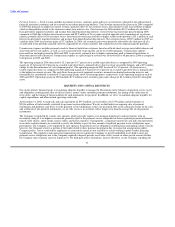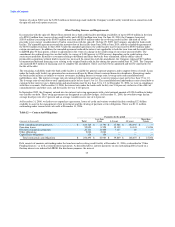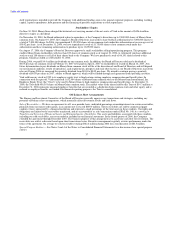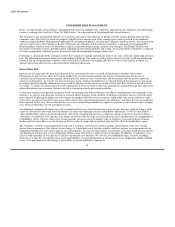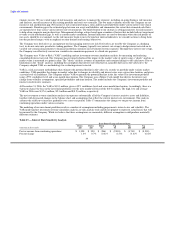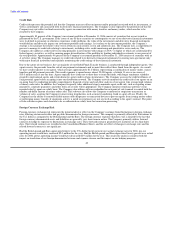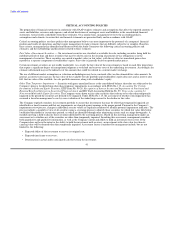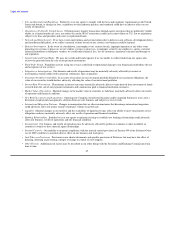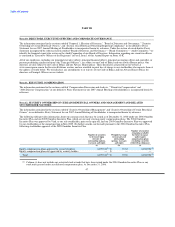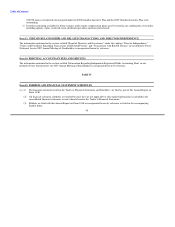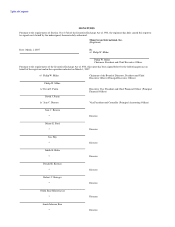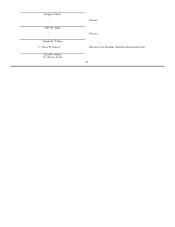MoneyGram 2006 Annual Report Download - page 45
Download and view the complete annual report
Please find page 45 of the 2006 MoneyGram annual report below. You can navigate through the pages in the report by either clicking on the pages listed below, or by using the keyword search tool below to find specific information within the annual report.
Table of Contents
• Extent of and length of time the investment has been in an unrealized loss position;
• Deterioration in the issuer's credit rating and/or the industry and geographical area in which the issuer operates;
• Anticipated investment portfolio rebalancing activities in response to environmental changes;
• Failure of asset-backed securities to meet minimum coverage or collateralization tests;
• New information regarding the investment or the issuer;
• Anticipated cash flow needs of the Company, including anticipated acquisitions and customer contract terminations, and the
sufficiency of anticipated cash and cash equivalent balances to meet these needs; and
• Other qualitative factors applicable to the investment in question.
In connection with anticipated dispositions to adjust the portfolio for duration or for asset allocation, the Company analyzes its
investment portfolio to recognize impairments for securities in an unrealized loss position for which the Company no longer has the
intent and ability to hold to recovery as a result of the analysis of the factors listed above.
The Company evaluates investments for beneficial interests in structured investments rated A and below for which risk of credit loss is
deemed more than remote for impairment under EITF Issue No. 99-20. When an adverse change in expected cash flows occurs, and if the
fair value of a security is less that its carrying value, the investment is written down to fair value.
Any security deemed to be other than temporarily impaired is written down to its then current market value, with the amount of the write-
down reflected in the Company's consolidated statement of income for that quarter.
The Company's methodology to identify potential impairments requires professional judgment. There are inherent risks and uncertainties
involved in making these judgments. Changes in circumstances and critical assumptions such as a continued weak economy, a more
pronounced economic downturn or unforeseen events which affect one or more companies, industry sectors or countries could result in
additional write-downs in future periods for impairments that are deemed other-than-temporary.
The risks and uncertainties include changes in general economic conditions, the issuer's financial condition or near term recovery
prospects, the effects of changes in interest rates, the length of time and the extent to which the market value of the investment has been
less than cost and the Company's intent and ability to hold the investment for a period of time sufficient to allow for any anticipated
recovery in market value. In addition, for securitized financial assets with contractual cash flows (e.g. asset-backed securities),
projections of expected future cash flows may change based upon new information regarding the performance of the underlying
collateral.
We recorded $5.2 million, $6.6 million and $15.9 million of other-than-temporary impairment losses in 2006, 2005 and 2004,
respectively, primarily related to other asset-backed securities, collateralized mortgage obligations and structured notes held in our
investment portfolio. During 2006, 2005 and 2004, we received $10.5 million, $12.6 million and $1.9 million in cash recoveries on
previously impaired securities. At December 31, 2006, 2005, and 2004, our investment portfolio has unrealized losses of $43.1 million,
$45.2 million and $19.4 million, respectively. Adverse changes in estimated cash flows in the future could result in impairment losses to
the extent that the recorded value of such investments exceeds fair value for a period deemed to be other-than-temporary.
Derivative Financial Instruments — Derivative financial instruments are used as part of our risk management strategy to manage
exposure to fluctuations in interest and foreign currency rates. We do not enter into derivatives for speculative purposes. Derivatives are
accounted for in accordance with SFAS No. 133, Accounting for Derivative Instruments and Hedging Activities, and its related
amendments and interpretations. The derivatives are recorded as either assets or liabilities on the balance sheet at fair value, with the
change in fair value recognized in earnings or in other comprehensive income depending on the use of the derivative and whether it
qualifies for hedge accounting. A derivative that does not qualify, or is not designated, as a hedge will be reflected at fair value, with
changes in value recognized through earnings. The estimated fair value of derivative financial instruments has been determined using
available market information and certain valuation methodologies.
Considerable judgment is required in interpreting market data to develop the estimates of fair value. Accordingly, the estimates
determined may not be indicative of the amounts that could be realized in a current market exchange. The use of different market
assumptions or valuation methodologies may have a material effect on the estimated fair value amounts.
42


